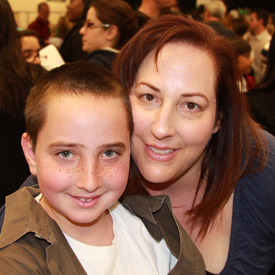We all know that the holidays can be stressful with the many demands of shopping, baking, parties and the expectation that you should be filled with cheer and goodwill. This is all daunting under the best circumstances, but if you are also losing your vision to eye diseases such as glaucoma, age-related macular degeneration or diabetic retinopathy, the depression can increase.
6 Tips to Help With Holiday Stress

Being realistic, planning ahead and asking for help will let you deal with the stress and depression that may come with the holidays. Here are six tips that will help you deal with the pressures of the holidays, with additional tips for those with vision loss.
- Begin by realizing you don’t have to be happy just because the holidays are here. You may have experienced a loss of someone close to you that makes celebrating the holidays hard.
With vision loss: You may miss seeing or putting up decorations; baking for friends and family; or seeing the joy and smiles of loved ones. You can’t force yourself to be cheerful because of the time of year. - While the common reaction to depression is stay home and isolate yourself, don’t, it will only make you feel worse and dwell on things you cannot change. Join friends when they ask you out, find community events to attend or volunteer. Sharing time with others can provide a welcome distraction and lift your spirits.
With vision loss: It is common to be uncomfortable with asking friends and family for a ride, but if they are attending the same party of community event, ask them if you can get a ride. They won’t mind a will be glad you are there. Worst case, call a taxi or use Uber. - Don’t expect perfection. You need to define for yourself what would make a great holiday and not let the media and retail stores tell you what the holidays should be. Also remember that your traditions will change as your family changes and grows. Look at this as an opportunity to be creative and start new traditions.
With vision loss: Scale your holiday to what is comfortable to you. If fewer decorations make it safer and easier for you to navigate around your home, then reduce the number of things that go up to a few larger items you can enjoy more easily – you can even “decorate” with holiday music.Even traditions may need to change. Allow someone else to host the family or neighborhood celebrations. It is nice to pass the honor on and you won’t be so stressed and tired you can’t enjoy the festivities.
- Plan ahead so you don’t feel the pressure. This refers to budgeting both time and money.
• Plan extra time for decorating, shopping, baking, wrapping presents, or any other activity you want to include. Rarely do things run smoothly, especially at holiday time.
• Decide how much money you can spend, and stick to it. To make money go further, give homemade gifts, start a gift exchange instead of shopping for everyone in your family or office, or make a donation to a charity in someone’s name.With vision loss: The same concepts apply – you need to budget your time and money.
- Don’t over extend yourself and learn to say no. If you don’t you may become resentful and overwhelmed. Friends and family will understand if you can’t do everything. If your guilt gets the better of you, ask the person making the request to help with the tasks. They will gain a new appreciation of what you do.
With vision loss: Don’t be afraid to let people know that you may not be able to do things as easily as you could in the past. No one, except you, know the limitations you have with your vision. It can be very uncomfortable for others if they think they are asking too much of you, and you could become resentful for being asked to do something beyond your capabilities. - Stay healthy. The best way to do this is to watch what you eat and drink, get plenty of sleep, continue any exercise routine you have and take time to relax.
• You will be tempted with lots of sweets and snacks. Try eating something healthy like cut veggies before you go to the party to curb your appetite. Remember to limit your alcohol because of the calories and the fact that it is a depressant.
• Sleep will keep you alert and better able to focus what you want to get done and will help keep you more positive.
• Exercise is a great way to help relieve the stress you feel, give you an extra burst of energy and help you clear your head.
• Taking 15-20 minutes to just listen to music, take a bath, go for a walk or read book can help you think more clearly and relax. You will actually get more done when you can “re-charge” yourself.With vision loss: Everything listed above is good for good eye health. A good diet of brightly colored fruits and vegetables and exercise are very important. Being tired can affect how well you see, and stress has been known to have an adverse effect on a person’s vision.
Because of the busy holiday season, this month we will only be publishing once a week, on Tuesdays.
12/8/15
 Susan DeRemer, CFRE
Susan DeRemer, CFRE
Vice President of Development
Discovery Eye Foundation




